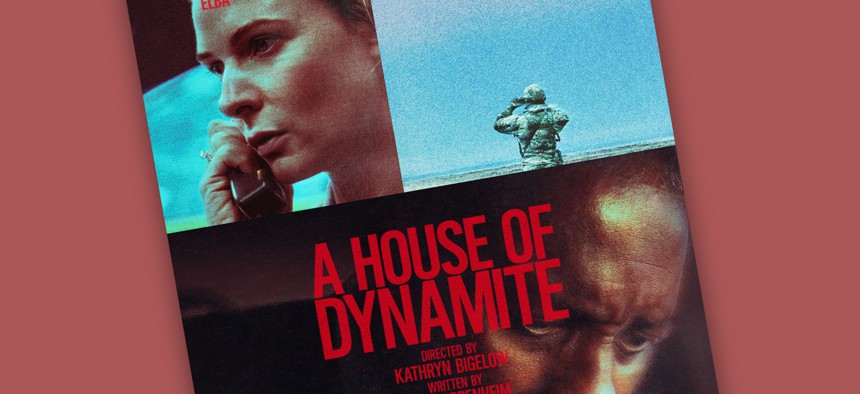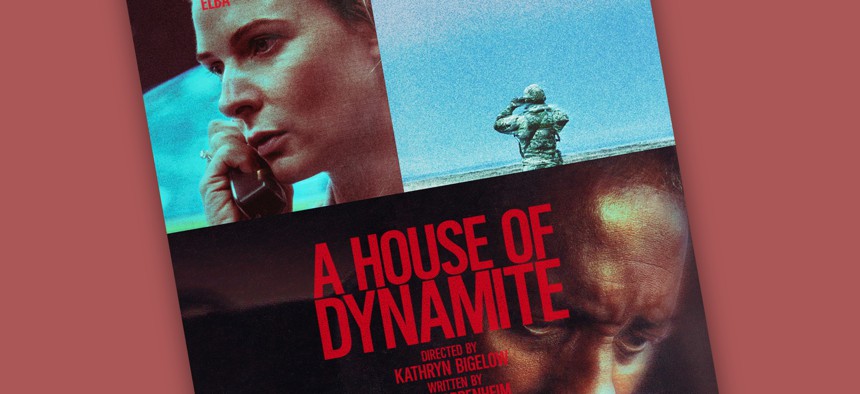
I have studied nuclear weapons for my entire adult life and I have watched more than a hundred movies with nuclear weapons in them—from Dr. Strangelove to Austin Powers, from The Day After to several Mission Impossible movies. I also served as Special Assistant to the President of the United States and Senior Director at the National Security Council responsible for things like nuclear arms control and policy. In short, I am a nuclear nerd and know a lot about nuclear weapons.
So I sat down to watch the new Netflix movie A House of Dynamite by Kathryn Bigelow knowing a few things about nuclear weapons in the real world and in the movies. And overall, I liked the movie it because it gets so many things right. Yet at the same time, this is not a movie for experts and nuclear wonks to love, because it gets so many other things wrong.
But as we say in government memos, the bottom line up front is they do get right perhaps the most important message: nuclear operators and officials like to project that they will always have perfect knowledge, get every decision right, and have every answer at their fingertips. In reality, it is certain that officials will not know enough, that they will get a lot of things wrong, and that the answer all along has been: do everything you can now to avoid a world where nuclear weapons can ever be used.
What it does well: The movie does very well on the process and the technology. They make the Nuclear Handbook—the binder with options for nuclear launches and strikes—look like the actual Nuclear Handbook. They make the offices for the Secretary of Defense, for the commander of U.S. Strategic Command, and even the President’s deep underground nuclear bunker look very authentic. A few liberties are taken, but the access they got to the White House and the facilities help it look and seem as realistic as any movie I have ever seen.
If I get one question more than any other from friends and family about my time at the White House, they want to know if it looks like The West Wing. And they are always disappointed when I say no: the Situation Room in the TV show was awesome, but the facilities in House of Dynamite are much closer to the truth.
Another thing the movie does well is portray the reality that America’s ability to shoot down incoming missiles is not very good. Perhaps my favorite line in the whole movie is from the defense secretary who says “$50 billion and the best you can do is a coin toss.” For analysts of U.S. missile defense efforts, we wish it were only $50 billion and as good as a 50-percent chance of intercepting an incoming missile.
What it does poorly: There is one major flaw in the movie, and that is the stereotype that the military leaders will be gung-ho to launch, and only some plucky civilian will be able to slow them down. This is neither how I have found the military leaders with whom I have worked, nor does the scenario painted in the movie justify the positions taken in the plot. Without giving anything away, the danger the U.S. faces is not one that would justify or likely even lead a gung ho military advisor telling the President he needed to launch any immediate retaliation. It is a shame, because some slight changes in the script could have made that stark reality and the dangerous premise of rapid launch, hair trigger responses more realistic. I will be curious to hear from laymen friends and family if they think that plot device misses the mark.
Lastly, the script makes some officials and personnel look great—from the situation room staff to the Secret Service—but makes others look weak and dithering. Sure, people can have off days, and a crisis can try even the best of minds. But trotting out the trope of people in high positions who do not take their jobs seriously, who do not know what they are supposed to be doing, and relying on that for a plot device is a little offensive to me. In reality, even the best people at their best in a nuclear crisis (or even a simulation) can make mistakes, misspeak, or get it wrong. An audience could come away from the film thinking a competent staff and president might have done better. Maybe. But maybe not.
In academia and think tanks, we debate nuclear strategy and doctrine, programs and numbers in a cold manner filled with certainty and conviction. There is a longstanding appreciation that discussing weapons of mass destruction capable of destroying humanity is often only possible by adopting cold, distanced language peppered with phrases like “collateral damage” and “single-shot kill probabilities.” So it is not surprising that in those debates, there is often an underlying assumption of ideal conditions, reliable communications, complete knowledge of the scenario, and confidence that decisions made will be well executed.
In House of Dynamite, no one can find the National Security Advisor. The secretary of defense drops off the call unexpectedly at a key moment. No one knows why the network of satellites the U.S. relies on to detect launches did not see the missile, so no one is really sure who it belongs to. On the basis of no evidence, they assume the missile is nuclear. And so the plot centers quietly but aptly on a key reality that often the experts and officials themselves forget or choose to ignore: people and knowledge are often imperfect. We assume all of the fingers on nuclear-launch buttons are rational, that phones and computers will work when needed, that people will be awake and around when called upon, and that on a sunny weekday, the president will be able to speak with and get informed advice from the right people in 20 minutes or less.
The reality is that time is limited and perfection elusive, and so some changes have been made to the nuclear system over the past 20 years. Officials and advisors have worked hard to reduce the need to respond to almost any attack immediately and to give the president or surviving successor time to make more informed decisions. But even with these changes, more must be done to create more reliable command-and-control systems, to ensure the ability of the government to survive an attack, to ensure leaders can talk to each other in crisis, and do more of it before a crisis strikes, to avoid nuclear weapons from ever being launched. It is a good thing that the United States and a number of other nuclear states have stated that a nuclear war cannot be won and must never be fought. It would be better if we believed it, and stopped the ongoing effort to prepare for one. Over the next 30 years, the U.S. alone will likely spend more than $2 trillion on nuclear weapons and missile defenses. Yet we lack a good sense of what might actually deter Russia, China, North Korea, or Iran from ever using a nuclear weapon against the U.S. or its friends and allies. By building more weapons and underinvesting in the real security that comes from nuclear risk reduction and stability, we ensure that the next generation too will be forced to live in a House of Dynamite.
Jon Wolfsthal is is the Director of Global Risk at the Federation of American Scientists.
The post What ‘House of Dynamite’ gets right and wrong about nuclear command and control appeared first on Defense One.




